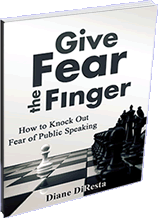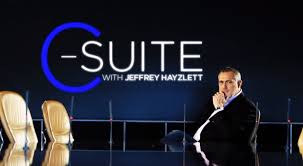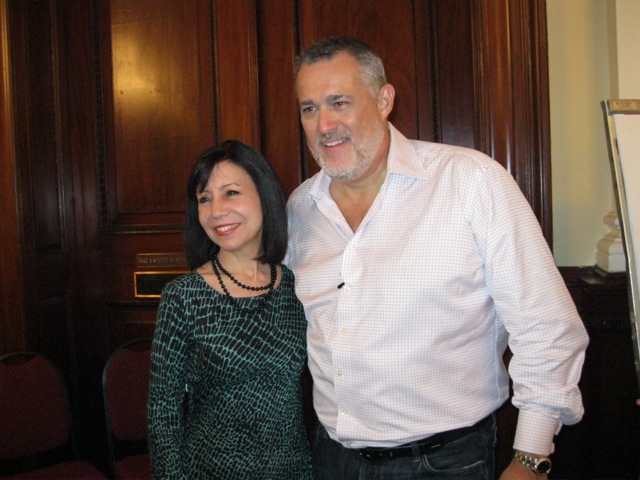 Guest blogger Dr. Paul Jenkins works with organizations and individuals to establish and maintain habitual patterns of positive perception and focus that increase happiness, engagement, productivity, profit, and ultimate achievement of professional and personal life missions.
Two things create – and cure – anxiety.
Guest blogger Dr. Paul Jenkins works with organizations and individuals to establish and maintain habitual patterns of positive perception and focus that increase happiness, engagement, productivity, profit, and ultimate achievement of professional and personal life missions.
Two things create – and cure – anxiety.
The brain and the mind.
In our previous post, Overcoming Fear of Public Speaking, Part I, we addressed the brain component, and how to calm the fight or flight response. The mind, on the other hand, is the ‘you’ inside that does the worrying, fretting, thinking, planning – and succeeding.
The mind is commonly thought of as having two primary parts – the conscious and the subconscious. The conscious is the part you are aware of. The subconscious is where the trouble is because you are not aware of it. The subconscious has a habit of asking, “What If?” The subconscious has a another habit of answering its own questions. The default subconscious answer to the What If question is:
You can’t handle that!
This creates a threat for the limbic system and triggers the fight or flight response.
You can feel the physical onset of anxiety – the fight or flight response – tightness in the chest, harder to breathe, heart pounds, sick feeling. This is caused by the chemical brain response to the subconscious default answer to What If.
Toolbox - Answer The What If Question
- Bring the What If question to the conscious mind
- Answer truthfully and intentionally
- Notice the fearful avoidant response and do it anyway
- Practice, practice, practice
When you get to the answer that you can handle it, your limbic system calms down and allows you to begin thinking again. The thinker solves the problem. Bring the What If up from the dark basement and solve it in the light.
You don’t have to want what you fear, just to get to the point that you know you could handle it.
The What If question itself strikes fear into the heart of many. A prominent undertaker commonly tells his clients when they are making pre-arranged funeral plans, "Thinking and talking about death won't kill you." In the same sense, taking on the What If question won't cause the feared thing to happen. Avoiding the question seeds more anxiety. Answering it truthfully, consciously, and intentionally frees the subconscious to let go of it.
A client shared this quotation with me: “Today is the tomorrow that you were afraid of yesterday.” Here it is, and there you are still handling everything as it comes. At the root of every fear is the same belief – that I can’t handle it. Nothing could be farther from the truth – you have already handled absolutely everything so far, and that will not be changing. Keep moving forward and know that you can handle it!
Remember this – You can handle anything that comes up in your life.
Haven’t you already handled everything so far?
About the Author
Dr. Paul Jenkins works with organizations and individuals to establish and maintain habitual patterns of positive perception and focus that increase happiness, engagement, productivity, profit, and ultimate achievement of professional and personal life missions.
With two decades of experience as a professional psychologist, Dr. Paul (as he is known to clients and his audiences) lays out the how and the why behind the art and science of being constructive in an often destructive environment. It is like having an owner’s manual for your brain – one you can actually read, understand, and apply. You understand your own mind and improve its functioning on purpose.
His deeply thoughtful writing, engaging and fun keynote addresses, powerfully practical breakout seminars, individual and corporate coaching and counseling are profound and simple. His clients, readers, and audiences get an iron grip on powerful Pathological Positivity principles that make an immediate difference in their personal and professional lives.
DrPaulJenkins.com

 Guest blogger Dr. Paul Jenkins works with organizations and individuals to establish and maintain habitual patterns of positive perception and focus that increase happiness, engagement, productivity, profit, and ultimate achievement of professional and personal life missions.
Two things create – and cure – anxiety.
Guest blogger Dr. Paul Jenkins works with organizations and individuals to establish and maintain habitual patterns of positive perception and focus that increase happiness, engagement, productivity, profit, and ultimate achievement of professional and personal life missions.
Two things create – and cure – anxiety.  Executive Presence
Executive Presence  This was the email from someone in my networking group after reading the title of my new ebook,
This was the email from someone in my networking group after reading the title of my new ebook,  How often have you seen a talented expert with good presentation skills, derail when they spoke to the C-Suite? My clients have complained about this issue. Their direct reports lose credibility with
How often have you seen a talented expert with good presentation skills, derail when they spoke to the C-Suite? My clients have complained about this issue. Their direct reports lose credibility with 



 Do you freeze up when you have to speak to senior management? Do you wonder how you can gain their attention and establish your credibility? Well, here's advice direct from the C-Suite.
Jeff Hayzlett, author of
Do you freeze up when you have to speak to senior management? Do you wonder how you can gain their attention and establish your credibility? Well, here's advice direct from the C-Suite.
Jeff Hayzlett, author of